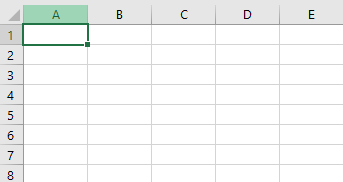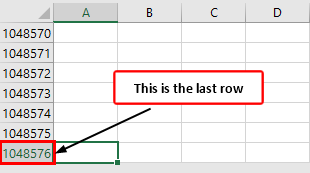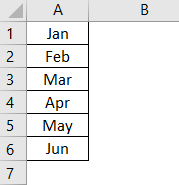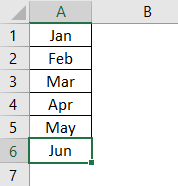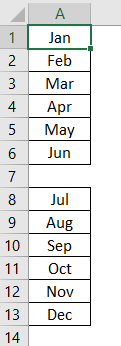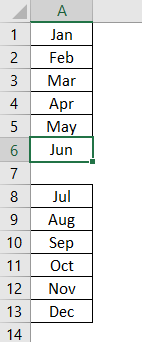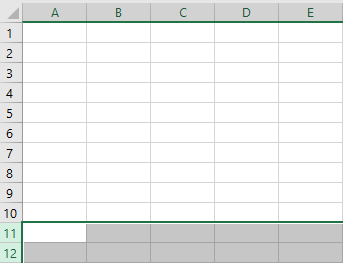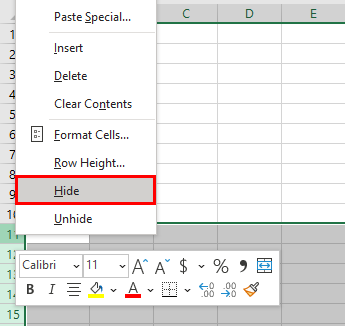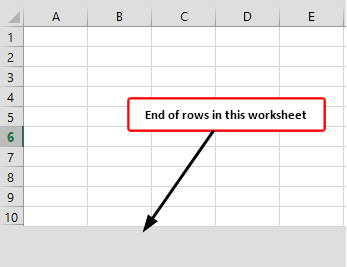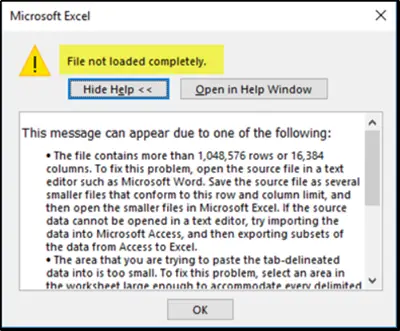Worksheet and workbook specifications and limits
|
Feature |
Maximum limit |
|---|---|
|
Open workbooks |
Limited by available memory and system resources |
|
Total number of rows and columns on a worksheet |
1,048,576 rows by 16,384 columns |
|
Column width |
255 characters |
|
Row height |
409 points |
|
Page breaks |
1,026 horizontal and vertical |
|
Total number of characters that a cell can contain |
32,767 characters |
|
Characters in a header or footer |
255 |
|
Maximum number of line feeds per cell |
253 |
|
Sheets in a workbook |
Limited by available memory (default is 1 sheet) |
|
Colors in a workbook |
16 million colors (32 bit with full access to 24 bit color spectrum) |
|
Named views in a workbook |
Limited by available memory |
|
Unique cell formats/cell styles |
65,490 |
|
Fill styles |
256 |
|
Line weight and styles |
256 |
|
Unique font types |
1,024 global fonts available for use; 512 per workbook |
|
Number formats in a workbook |
Between 200 and 250, depending on the language version of Excel that you have installed |
|
Names in a workbook |
Limited by available memory |
|
Windows in a workbook |
Limited by available memory |
|
Hyperlinks in a worksheet |
65,530 |
|
Panes in a window |
4 |
|
Linked sheets |
Limited by available memory |
|
Scenarios |
Limited by available memory; a summary report shows only the first 251 scenarios |
|
Changing cells in a scenario |
32 |
|
Adjustable cells in Solver |
200 |
|
Custom functions |
Limited by available memory |
|
Zoom range |
10 percent to 400 percent |
|
Reports |
Limited by available memory |
|
Sort references |
64 in a single sort; unlimited when using sequential sorts |
|
Undo levels |
100 |
|
Fields in a data form |
32 |
|
Workbook parameters |
255 parameters per workbook |
|
Items displayed in filter drop-down lists |
10,000 |
|
Noncontiguous cells that can be selected |
2,147,483,648 cells |
|
Maximum limits of memory storage and file size for Data Model workbooks |
32-bit environment is subject to 2 gigabytes (GB) of virtual address space, shared by Excel, the workbook, and add-ins that run in the same process. A data model’s share of the address space might run up to 500 – 700 megabytes (MB), but could be less if other data models and add-ins are loaded. 64-bit environment imposes no hard limits on file size. Workbook size is limited only by available memory and system resources. Beginning with Excel 2016, Large Address Aware functionality lets 32-bit Excel consume twice the memory when users work on a 64-bit Windows operating system. For more information, see Large Address Aware capability change for Excel. Note: Adding tables to the Data Model increases the file size. If you don’t plan to create complex Data Model relationships using many data sources and data types in your workbook, uncheck the Add this data to the Data Model box when you import or create tables, pivot tables, or data connections. For more information, see Data Model specification and limits. |
|
Processor Cores |
64 |
|
File name length |
218 characters — This includes the file path. For example, C:UsernameDocumentsFileName.xlsx. |
Calculation specifications and limits
|
Feature |
Maximum limit |
|---|---|
|
Number precision |
15 digits |
|
Smallest allowed negative number |
-2.2251E-308 |
|
Smallest allowed positive number |
2.2251E-308 |
|
Largest allowed positive number |
9.99999999999999E+307 |
|
Largest allowed negative number |
-9.99999999999999E+307 |
|
Largest allowed positive number via formula |
1.7976931348623158e+308 |
|
Largest allowed negative number via formula |
-1.7976931348623158e+308 |
|
Length of formula contents |
8,192 characters |
|
Internal length of formula |
16,384 bytes |
|
Iterations |
32,767 |
|
Worksheet arrays |
Limited by available memory |
|
Selected ranges |
2,048 |
|
Arguments in a function |
255 |
|
Nested levels of functions |
64 |
|
User defined function categories |
255 |
|
Number of available worksheet functions |
341 |
|
Size of the operand stack |
1,024 |
|
Cross-worksheet dependency |
64,000 worksheets that can refer to other sheets |
|
Cross-worksheet array formula dependency |
Limited by available memory |
|
Area dependency |
Limited by available memory |
|
Area dependency per worksheet |
Limited by available memory |
|
Dependency on a single cell |
4 billion formulas that can depend on a single cell |
|
Linked cell content length from closed workbooks |
32,767 |
|
Earliest date allowed for calculation |
January 1, 1900 (January 1, 1904, if 1904 date system is used) |
|
Latest date allowed for calculation |
December 31, 9999 |
|
Largest amount of time that can be entered |
9999:59:59 |
Charting specifications and limits
|
Feature |
Maximum limit |
|---|---|
|
Charts linked to a worksheet |
Limited by available memory |
|
Worksheets referred to by a chart |
255 |
|
Data series in one chart |
255 |
|
Data points in a data series for 2-D charts |
Limited by available memory |
|
Data points in a data series for 3-D charts |
Limited by available memory |
|
Data points for all data series in one chart |
Limited by available memory |
PivotTable and PivotChart report specifications and limits
|
Feature |
Maximum limit |
|---|---|
|
PivotTable reports on a sheet |
Limited by available memory |
|
Unique items per field |
1,048,576 |
|
Row or column fields in a PivotTable report |
Limited by available memory |
|
Report filters in a PivotTable report |
256 (may be limited by available memory) |
|
Value fields in a PivotTable report |
256 |
|
Calculated item formulas in a PivotTable report |
Limited by available memory |
|
Report filters in a PivotChart report |
256 (may be limited by available memory) |
|
Value fields in a PivotChart report |
256 |
|
Calculated item formulas in a PivotChart report |
Limited by available memory |
|
Length of the MDX name for a PivotTable item |
32,767 |
|
Length for a relational PivotTable string |
32,767 |
|
Items displayed in filter drop-down lists |
10,000 |
Workbooks with the «Allow changes by more than one user…» setting enabled
If the Allow changes by more than one user… setting is on for a workbook, then the following information applies. This setting is accessible by clicking the Review tab > Share Workbook. Note that in newer versions of Excel, the Share Workbook button has been hidden. To unhide it, click File > Options > Quick Access Toolbar. Open the list under Choose commands from and select All Commands. Scroll down that list until you see Share Workbook (Legacy). Select that item and click Add. Click OK. The Share Workbook button is now at the top of the Excel window.
|
Feature |
Maximum limit |
|---|---|
|
Users who can open the file at the same time |
256 |
|
Personal views in the workbook |
Limited by available memory |
|
Days that change history is maintained |
32,767 (default is 30 days) |
|
Workbooks that can be merged at one time |
Limited by available memory |
|
Cells that can be highlighted |
32,767 |
|
Colors used to identify changes made by different users when change highlighting is turned on |
32 (each user is identified by a separate color; changes made by the current user are highlighted with navy blue) |
|
Excel tables in the workbook |
0 (zero) Note: A workbook that contains one or more Excel tables cannot have the Allow changes by more than one user… setting enabled. |
Worksheet and workbook specifications and limits
|
Feature |
Maximum limit |
|---|---|
|
Open workbooks |
Limited by available memory and system resources |
|
Total number of rows and columns on a worksheet |
1,048,576 rows by 16,384 columns |
|
Column width |
255 characters |
|
Row height |
409 points |
|
Page breaks |
1,026 horizontal and vertical |
|
Total number of characters that a cell can contain |
32,767 characters |
|
Characters in a header or footer |
255 |
|
Maximum number of line feeds per cell |
253 |
|
Sheets in a workbook |
Limited by available memory (default is 3 sheets) |
|
Colors in a workbook |
16 million colors (32 bit with full access to 24 bit color spectrum) |
|
Named views in a workbook |
Limited by available memory |
|
Unique cell formats/cell styles |
65,490 |
|
Fill styles |
256 |
|
Line weight and styles |
256 |
|
Unique font types |
1,024 global fonts available for use; 512 per workbook |
|
Number formats in a workbook |
Between 200 and 250, depending on the language version of Excel that you have installed |
|
Names in a workbook |
Limited by available memory |
|
Windows in a workbook |
Limited by available memory |
|
Hyperlinks in a worksheet |
65,530 hyperlinks |
|
Panes in a window |
4 |
|
Linked sheets |
Limited by available memory |
|
Scenarios |
Limited by available memory; a summary report shows only the first 251 scenarios |
|
Changing cells in a scenario |
32 |
|
Adjustable cells in Solver |
200 |
|
Custom functions |
Limited by available memory |
|
Zoom range |
10 percent to 400 percent |
|
Reports |
Limited by available memory |
|
Sort references |
64 in a single sort; unlimited when using sequential sorts |
|
Undo levels |
100 |
|
Fields in a data form |
32 |
|
Workbook parameters |
255 parameters per workbook |
|
Items displayed in filter drop-down lists |
10,000 |
|
Noncontiguous cells that can be selected |
2,147,483,648 cells |
|
Processor Cores |
64 |
Calculation specifications and limits
|
Feature |
Maximum limit |
|---|---|
|
Number precision |
15 digits |
|
Smallest allowed negative number |
-2.2251E-308 |
|
Smallest allowed positive number |
2.2251E-308 |
|
Largest allowed positive number |
9.99999999999999E+307 |
|
Largest allowed negative number |
-9.99999999999999E+307 |
|
Largest allowed positive number via formula |
1.7976931348623158e+308 |
|
Largest allowed negative number via formula |
-1.7976931348623158e+308 |
|
Length of formula contents |
8,192 characters |
|
Internal length of formula |
16,384 bytes |
|
Iterations |
32,767 |
|
Worksheet arrays |
Limited by available memory |
|
Selected ranges |
2,048 |
|
Arguments in a function |
255 |
|
Nested levels of functions |
64 |
|
User defined function categories |
255 |
|
Number of available worksheet functions |
341 |
|
Size of the operand stack |
1,024 |
|
Cross-worksheet dependency |
64,000 worksheets that can refer to other sheets |
|
Cross-worksheet array formula dependency |
Limited by available memory |
|
Area dependency |
Limited by available memory |
|
Area dependency per worksheet |
Limited by available memory |
|
Dependency on a single cell |
4 billion formulas that can depend on a single cell |
|
Linked cell content length from closed workbooks |
32,767 |
|
Earliest date allowed for calculation |
January 1, 1900 (January 1, 1904, if 1904 date system is used) |
|
Latest date allowed for calculation |
December 31, 9999 |
|
Largest amount of time that can be entered |
9999:59:59 |
Charting specifications and limits
|
Feature |
Maximum limit |
|---|---|
|
Charts linked to a worksheet |
Limited by available memory |
|
Worksheets referred to by a chart |
255 |
|
Data series in one chart |
255 |
|
Data points in a data series for 2-D charts |
Limited by available memory |
|
Data points in a data series for 3-D charts |
Limited by available memory |
|
Data points for all data series in one chart |
Limited by available memory |
PivotTable and PivotChart report specifications and limits
|
Feature |
Maximum limit |
|---|---|
|
PivotTable reports on a sheet |
Limited by available memory |
|
Unique items per field |
1,048,576 |
|
Row or column fields in a PivotTable report |
Limited by available memory |
|
Report filters in a PivotTable report |
256 (may be limited by available memory) |
|
Value fields in a PivotTable report |
256 |
|
Calculated item formulas in a PivotTable report |
Limited by available memory |
|
Report filters in a PivotChart report |
256 (may be limited by available memory) |
|
Value fields in a PivotChart report |
256 |
|
Calculated item formulas in a PivotChart report |
Limited by available memory |
|
Length of the MDX name for a PivotTable item |
32,767 |
|
Length for a relational PivotTable string |
32,767 |
|
Items displayed in filter drop-down lists |
10,000 |
Workbooks with the «Allow changes by more than one user…» setting enabled
If the Allow changes by more than one user… setting is on for a workbook, then the following information applies. This setting is accessible by clicking the Review tab > Share Workbook.
|
Feature |
Maximum limit |
|---|---|
|
Users who can open and share the file at the same time |
256 |
|
Personal views in the workbook |
Limited by available memory |
|
Days that change history is maintained |
32,767 (default is 30 days) |
|
Workbooks that can be merged at one time |
Limited by available memory |
|
Cells that can be highlighted in the workbook |
32,767 |
|
Colors used to identify changes made by different users when change highlighting is turned on |
32 (each user is identified by a separate color; changes made by the current user are highlighted with navy blue) |
|
Excel tables in the workbook |
0 (zero) Note: A workbook that contains one or more Excel tables cannot have the Allow changes by more than one user… setting enabled. |
Worksheet and workbook specifications and limits
|
Feature |
Maximum limit |
|---|---|
|
Open workbooks |
Limited by available memory and system resources |
|
Total number of rows and columns on a worksheet |
1,048,576 rows by 16,384 columns |
|
Column width |
255 characters |
|
Row height |
409 points |
|
Page breaks |
1,026 horizontal and vertical |
|
Total number of characters that a cell can contain |
32,767 characters |
|
Characters in a header or footer |
255 |
|
Maximum number of line feeds per cell |
253 |
|
Sheets in a workbook |
Limited by available memory (default is 3 sheets) |
|
Colors in a workbook |
16 million colors (32 bit with full access to 24 bit color spectrum) |
|
Named views in a workbook |
Limited by available memory |
|
Unique cell formats/cell styles |
65,490 |
|
Fill styles |
256 |
|
Line weight and styles |
256 |
|
Unique font types |
1,024 global fonts available for use; 512 per workbook |
|
Number formats in a workbook |
Between 200 and 250, depending on the language version of Excel that you have installed |
|
Names in a workbook |
Limited by available memory |
|
Windows in a workbook |
Limited by available memory |
|
Hyperlinks in a worksheet |
65,530 hyperlinks |
|
Panes in a window |
4 |
|
Linked sheets |
Limited by available memory |
|
Scenarios |
Limited by available memory; a summary report shows only the first 251 scenarios |
|
Changing cells in a scenario |
32 |
|
Adjustable cells in Solver |
200 |
|
Custom functions |
Limited by available memory |
|
Zoom range |
10 percent to 400 percent |
|
Reports |
Limited by available memory |
|
Sort references |
64 in a single sort; unlimited when using sequential sorts |
|
Undo levels |
100 |
|
Fields in a data form |
32 |
|
Workbook parameters |
255 parameters per workbook |
|
Filter drop-down lists |
10,000 |
Calculation specifications and limits
|
Feature |
Maximum limit |
|---|---|
|
Number precision |
15 digits |
|
Smallest allowed negative number |
-2.2251E-308 |
|
Smallest allowed positive number |
2.2251E-308 |
|
Largest allowed positive number |
9.99999999999999E+307 |
|
Largest allowed negative number |
-9.99999999999999E+307 |
|
Largest allowed positive number via formula |
1.7976931348623158e+308 |
|
Largest allowed negative number via formula |
-1.7976931348623158e+308 |
|
Length of formula contents |
8,192 characters |
|
Internal length of formula |
16,384 bytes |
|
Iterations |
32,767 |
|
Worksheet arrays |
Limited by available memory |
|
Selected ranges |
2,048 |
|
Arguments in a function |
255 |
|
Nested levels of functions |
64 |
|
User defined function categories |
255 |
|
Number of available worksheet functions |
341 |
|
Size of the operand stack |
1,024 |
|
Cross-worksheet dependency |
64,000 worksheets that can refer to other sheets |
|
Cross-worksheet array formula dependency |
Limited by available memory |
|
Area dependency |
Limited by available memory |
|
Area dependency per worksheet |
Limited by available memory |
|
Dependency on a single cell |
4 billion formulas that can depend on a single cell |
|
Linked cell content length from closed workbooks |
32,767 |
|
Earliest date allowed for calculation |
January 1, 1900 (January 1, 1904, if 1904 date system is used) |
|
Latest date allowed for calculation |
December 31, 9999 |
|
Largest amount of time that can be entered |
9999:59:59 |
Charting specifications and limits
|
Feature |
Maximum limit |
|---|---|
|
Charts linked to a worksheet |
Limited by available memory |
|
Worksheets referred to by a chart |
255 |
|
Data series in one chart |
255 |
|
Data points in a data series for 2-D charts |
32,000 |
|
Data points in a data series for 3-D charts |
4,000 |
|
Data points for all data series in one chart |
256,000 |
PivotTable and PivotChart report specifications and limits
|
Feature |
Maximum limit |
|---|---|
|
PivotTable reports on a sheet |
Limited by available memory |
|
Unique items per field |
1,048,576 |
|
Row or column fields in a PivotTable report |
Limited by available memory |
|
Report filters in a PivotTable report |
256 (may be limited by available memory) |
|
Value fields in a PivotTable report |
256 |
|
Calculated item formulas in a PivotTable report |
Limited by available memory |
|
Report filters in a PivotChart report |
256 (may be limited by available memory) |
|
Value fields in a PivotChart report |
256 |
|
Calculated item formulas in a PivotChart report |
Limited by available memory |
|
Length of the MDX name for a PivotTable item |
32,767 |
|
Length for a relational PivotTable string |
32,767 |
Workbooks with the «Allow changes by more than one user…» setting enabled
If the Allow changes by more than one user… setting is on for a workbook, then the following information applies. This setting is enabled when using Shared Workbooks.
|
Feature |
Maximum limit |
|---|---|
|
Users who can open and share the workbook at the same time |
256 |
|
Personal views in the workbook |
Limited by available memory |
|
Days that change history is maintained |
32,767 (default is 30 days) |
|
Workbooks that can be merged at one time |
Limited by available memory |
|
Cells that can be highlighted |
32,767 |
|
Colors used to identify changes made by different users when change highlighting is turned on |
32 (each user is identified by a separate color; changes made by the current user are highlighted with navy blue) |
|
Excel tables in the workbook |
0 (zero) Note: A workbook that contains one or more Excel tables cannot have the Allow changes by more than one user… setting enabled. |
Top of Page
Have a look at this link** and this one (and this for 2013). A quick summary:
+-----------------+-----------+--------------+---------------------+
| | Max. Rows | Max. Columns | Max. Cols by letter |
+-----------------+-----------+--------------+---------------------+
| Excel 365* | 1,048,576 | 16,384 | XFD |
| Excel 2013 | 1,048,576 | 16,384 | XFD |
| Excel 2010 | 1,048,576 | 16,384 | XFD |
| Excel 2007 | 1,048,576 | 16,384 | XFD |
| Excel 2003 | 65,536 | 256 | IV |
| Excel 2002 (XP) | 65,536 | 256 | IV |
| Excel 2000 | 65,536 | 256 | IV |
| Excel 97 | 65,536 | 256 | IV |
| Excel 95 | 16,384 | 256 | IV |
| Excel 5 | 16,384 | 256 | IV |
+-----------------+-----------+--------------+---------------------+
*Excel 365 unverified.
**This (web archive) link probably will not work with your browser, but the information is in the page source.
How to Find the Maximum Number of Rows in Excel?
Table of contents
- How to Find the Maximum Number of Rows in Excel?
- Limit User Action to Specific Number of Rows in Excel
- Using Hide Method
- Things to Remember
- Recommended Articles
- Limit User Action to Specific Number of Rows in Excel
For example, look at the below worksheet preview.
The active cell is the A1 cell. To go to the last row of this column, we need to press the shortcut key “Ctrl + Down Arrow.” It will take us to the last row in the selected cell column.
But one thing we need to know about this shortcut is it will take us to the last used cell without a cell break.
For example, look at the below data preview.
We have some data in the first 6 rows of column 1, and the active cell is the A1 cell. If we press “Ctrl + Down Arrow, “it will take you to the last used cell, not to the last row of the worksheet.
This shortcut key will go to the last used cell without cell breaks. For example, look at the below data preview.
After the first 6 rows, we have a line break of one row, and after that cell break, we have data in another 6 rows. So first, we will press the shortcut key “Ctrl + Down Arrow.” It will take me to the last used row before the cell break, the 6th row.
Again, we will press the shortcut key “Ctrl + Down Arrow” and see where it will go.
Upon pressing the shortcut key one more time, it has jumped to the next used cell, not to the end of the last used cell. So now, we must press the “Ctrl + Down Arrow” key. It will take us to another last used row, the 13th row.
Now, if we press the “Ctrl + Down Arrow,” it will take us to the last row of the worksheet. Like this, going to the maximum number of rows with Excel works.
Limit User Action to Specific Number of Rows in Excel
Often, we do not want users to use all the rows. Rather, we want them to work with a specific range of cells or rows. We can do this by using multiple methods. Below are the ways to restrict user action to particular rows.
Using Hide Method
For example, if we want to allow a user to work with the first ten rows of the data, we can hide the remaining rows except for the first 10 rows.
- To hide from the 11th row onwards, we must select all the rows till the 10,48,576 rows.
- Now right-click on the row headerExcel Row Header is the grey column on the left side of column 1 in the worksheet that contains the numbers (1, 2, 3, etc.). To hide or reveal row and column headers, press ALT + W + V + H.read more and choose the option of “Hide.”
- It will hide all the selected rows, and the user can see only 10 rows.
We can use shortcut keys to hide«Ctrl + 9» and «Ctrl + 0» are the keyboard shortcuts for hiding excel rows and columns, respectively. To use this method, pick any cell in a row or column, then press 0 or 9 while holding down the ctrl key.read more rows if we do not want to follow the manual right-clicking and hiding method.
After selecting several rows to be hidden, press the shortcut key “Ctrl + 9” (Number 9 should be from the keyboard number, not from the number pad of the keyboard). It will simply hide the rows.
Like this, we can limit the action of users with specific worksheets.
Things to Remember
- Excel 2003 version has only 65,536 rows only.
- From the Excel 2007 version onwards, we have more than 1 million rows.
- If we use all the rows, then the computer should be equipped with a well-versed processor, and RAM capacity should be not less than 8 GB.
Recommended Articles
This article is a guide to the Maximum Number of Rows in Excel. We discuss finding the last row and restricting user action to specific rows in Excel and a downloadable template. You may learn more about Excel from the following articles: –
- Max Formula in Excel
- Count Number of Excel Rows & Columns
- MINVERSE in Excel
- Rows Function in Excel
1,048,576 rows.
Worksheet and workbook specifications and limits
| Feature | Maximum limit |
|---|---|
| Total number of rows and columns on a worksheet | 1,048,576 rows by 16,384 columns |
| Column width | 255 characters |
| Row height | 409 points |
| Page breaks | 1,026 horizontal and vertical |
Contents
- 1 Is there a limit on Excel rows?
- 2 Can Excel handle 4 million rows?
- 3 Can Excel handle 20000 rows?
- 4 Can Excel handle 10000 rows?
- 5 How do I select only 1000 rows in Excel?
- 6 What is Max function in Excel?
- 7 Can Excel handle 2 million rows?
- 8 Can Excel handle 1 million rows?
- 9 How much data can Excel handle before it slows down?
- 10 Can CSV have more than 1 million rows?
- 11 How do I select 25000 rows in Excel?
- 12 Why Excel is not filter more than 10000?
- 13 How do I select 10000 rows in Excel?
- 14 How do you remove limits from Excel?
- 15 How do I do a hyperlink that exceeds 255 characters?
- 16 How do I bypass the character limit in Excel?
- 17 How do I insert 2000 rows in Excel?
- 18 How do I select 2000 rows in Excel?
- 19 What is the formula for Max?
- 20 How do you calculate maximum?
Is there a limit on Excel rows?
Yes, Excel has maximum row limits! According to Microsoft Support (2021): Excel’s maximum row limit is 1,048,576. Columns are limited to 16,384. This applies to Excel for Microsoft 365, Excel 2019, Excel 2016, Excel 2013, Excel 2010, and Excel 2007.
Can Excel handle 4 million rows?
Not many people need to bring 4 million rows of data into Excel. Point accepted.If you’ve ever checked (Press End then the down arrow key) Excel has just over 1 million rows, but if you start adding a formula or two to those rows then you will soon have issues.
Can Excel handle 20000 rows?
xlsb workbooks have 1,048,576 rows per sheet. These limits are hard-coded and cannot be changed. You can’t increase the number of rows in a spreadsheet in Excel 2007. Excel 2010 has the ability to use the Power Pivot Add-in which has no row limit.
Can Excel handle 10000 rows?
10,000 is just filtering drop-down list limit and not filtering limit. You can use “Number Filters” or “Text Filters” to use logic to filter those columns with more than 10,000 unique values.
How do I select only 1000 rows in Excel?
Dear Candidate, NOW simply press SHIFT+Space on your keyword it will automatically select your whole 1000 number row. 4. Then, press Ctrl+Shift+Up Arrow it will select your first 1000 rows in Excel.
What is Max function in Excel?
The Microsoft Excel MAX function returns the largest value from the numbers provided.It can be used as a worksheet function (WS) in Excel. As a worksheet function, the MAX function can be entered as part of a formula in a cell of a worksheet.
Can Excel handle 2 million rows?
You may know that Excel has a physical limit of 1 million rows (well, its 1,048,576 rows). But that doesn’t mean you can’t analyze more than a million rows in Excel. The trick is to use Data Model.
Can Excel handle 1 million rows?
A common myth I hear very frequently is that you can’t work with more than 1 million records in Excel. Actually, the right myth should be that you can’t use more than 1,048,576 rows, since this is the number of rows on each sheet; but even this one is false.
How much data can Excel handle before it slows down?
Finally, the last reason that Excel can run slow is because of its size limit. Excel maxes out at 1 million rows. That means that not only will Excel be running slow, but you’ll be running slow as you have to split your time between multiple spreadsheets.
Can CSV have more than 1 million rows?
You can’t open big files in a standard way, but you can create a connection to a CSV file.This works by loading data into Data Model, keeping a link to the original CSV file. This will allow you to load millions of rows.
How do I select 25000 rows in Excel?
For Excel (Windows 10, Office 365 at least) this is very easy.
- Click to select a cell within your table of data.
- Press the “End” key to tell Excel that you want to select all cells until the end of the table of data.
- Now press and hold the “Shift” key and then press one of the four arrow keys.
Why Excel is not filter more than 10000?
If you have more than 1,000 unique items in the list, only the first 1,000 items appear. In Excel 2007 and higher versions, the AutoFilter DropDown list will show the first 10,000 unique items. If you have more than 10,000 unique items in the list, only the first 10,000 items appear.
How do I select 10000 rows in Excel?
Select one or more rows and columns
Select the letter at the top to select the entire column. Or click on any cell in the column and then press Ctrl + Space. Select the row number to select the entire row. Or click on any cell in the row and then press Shift + Space.
How do you remove limits from Excel?
Select the cell you want to clear the restricted value, then click Data > Data Validation. See screenshot: 2. In the opening Data Validation dialog box, please click the Clear All button under the Settings tab, and then click the OK button.
How do I do a hyperlink that exceeds 255 characters?
The 255 character limit applies to how many characters you can put in one cell’s formula bar but not necessarily to how long a Hyperlink URL could be. A way around the 255 character limit in the formula bar would be to split the URL into two cells e.g. half the URL in cell A1 and the other half in cell A2.
How do I bypass the character limit in Excel?
Select the Data tab in the toolbar at the top of the screen. Then in the Data Tools group, click on the Data Validation drop-down and select Data Validation. When the Data Validation window appears, set up your criteria. In this example, we’ve setup the cells to allow a text length of less than or equal to 15.
How do I insert 2000 rows in Excel?
How to insert multiple rows in Excel
- Select the row below where you want the new rows to appear.
- Right click on the highlighted row and select “Insert” from the list.
- To insert multiple rows, select the same number of rows that you want to insert.
How do I select 2000 rows in Excel?
For Excel (Windows 10, Office 365 at least) this is very easy.
- Click to select a cell within your table of data.
- Press the “End” key to tell Excel that you want to select all cells until the end of the table of data.
- Now press and hold the “Shift” key and then press one of the four arrow keys.
What is the formula for Max?
The MAX function in Excel returns the highest value in a set of data that you specify. The syntax is as follows: MAX(number1, [number2], …) Where number can be represented by a numeric value, array, named range, a reference to a cell or range containing numbers.
How do you calculate maximum?
Formula
- =MAX(number1, [number2], …)
- Number1 and number2 are the arguments used for the function, where Number1 is required and the subsequent values are optional.
Download PC Repair Tool to quickly find & fix Windows errors automatically
The theoretical limit of rows and columns in the Microsoft Office application, Excel is well defined. If you exceed this mark, you are prompted with a ‘File not loaded completely’ popup message. It bears the following description:
- The file contains more than 1,048,576 rows or 16,384 columns. To fix this problem, open the source file in a text editor such as Microsoft Office Word. Save the source file as several smaller files that conform to this row and column limit, and then open the smaller files in Microsoft Office Excel. If the source data cannot be opened in a text editor, try importing the data into Microsoft Office Access, and then exporting subsets of the data from Access to Excel.
- The area that you are trying to paste the tab-delineated data into is too small. To fix this problem, select an area in the worksheet large enough to accommodate every delimited item.
So, what’s the maximum number of rows and columns supported in an Excel worksheet? Let’s find out!
Excel supports three Worksheets in a Workbook file, and each Worksheet can support up to 1,048,576 rows and 16,384 columns of data. Workbooks, however, can have more than 3 Worksheets if the computer supports enough memory for the additional data.
A handful of Office users seem to believe that 64-bit Excel can support more rows or columns than the 32-bit version. Is it true? While it might seem possible theoretically or remotely, it’s certainly not true as the number of rows/columns is limited by the version of the product and not by a number of ‘BITS’ it supports.
Moreover, having larger worksheet sizes exclusively for 64-bit Excel would cause some sorts of unknown compatibility issues. Microsoft strongly desires to keep its Worksheet accessible to all copies of Excel and version, regardless of whether it is 32-bit and 64-bit. Only when data is inserted into a Worksheet, other factors like how much memory the computer has, play a role in defining the rows, columns, cells limits.
Having said that, there’s one way via which you can find the number of rows and columns in Excel Worksheet and answer the question yourself. Here’s how!
- For determining the maximum number of rows, place the cursor in an empty column and press Ctrl + Down Arrow. The action will take you to the last row.
- Similarly, to find the maximum number of columns, place the cursor in an empty row and press Ctrl + Right Arrow. This will take you to the last column.
For other additional information, you can visit this Office Support Page.
A post-graduate in Biotechnology, Hemant switched gears to writing about Microsoft technologies and has been a contributor to TheWindowsClub since then. When he is not working, you can usually find him out traveling to different places or indulging himself in binge-watching.

